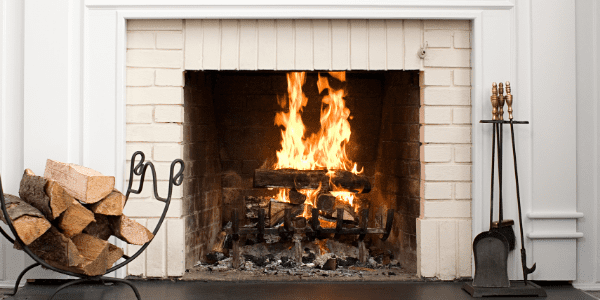How to Prepare Your House for Winter

With winter well on its way, there are some things you should do to start preparing your home. Properly preparing your house for winter can save you on your electric bill, and will help keep your house warm all winter long. Plus, preparing early can help you avoid extra costs caused by avoidable damage to your home. Make sure to complete each item on this checklist to properly prepare your house for winter.
Reverse Your Ceiling Fans
Most ceiling fans have a reverse switch. If yours does, reverse your fan to run the blades clockwise. With the ceiling fan reversed, it will push hot air from the ceiling back into the room. This is especially useful in rooms with high ceilings, and may even help cut back on heating costs.
Test the Heating System
As the weather starts to shift, make sure to test your heating system. To test your heating system, set the thermostat to around 80 degrees. You should be able to hear the furnace turn on, and then feel warm air within a few minutes. If everything checks out, you can turn your thermostat back to its normal settings. If not, try to diagnose the issue or call an expert.
Replace Your Air Filter
Before winter hits, replace the air filter in your furnace. Doing this will ensure clean, free-flowing air in your home. Check the recommendations for your furnace, as each one is different. Typically, manufacturers will recommend changing your air filter every month.
Clear Heating Vents
Check and clean your heating vents so that air can flow easily all winter long. For the best results, have a professional clean your heating vents every 2 to 3 years.
Prepare Your Fireplace
If you have a woodburning fireplace, you will want to properly prepare it before winter hits. First, check the chimney to make sure it is clear of any animal nests. Then, check the damper to make sure it fully locks in the open and closed position. This is essential for avoiding cold air leaks during the winter. Next, you’ll want to check the chimney draft to make sure smoke moves upwards, not into your home. You can do this by rolling up a few pieces of newspaper. With the damper open, light the newspaper in the fireplace. The smoke should rise up and out of the chimney. If instead, it starts to fill the house, you should call a professional to clean your chimney.
Seal Unused Fireplaces
If you have a fireplace but don’t use it, it may be best to seal it. This way, it won’t leak cold air into your home. To seal it in a way that is not permanent, simply cut a piece of fiberglass insulation and stuff it into your fireplace behind the glass doors. This will block any cold air in your fireplace from coming into your home. If you ever want to have a fire, you can simply remove the insulation and return it after the fire is completely out.
Insulate Hot Water Heater
Insulating your hot water heater is easy to do, and will save you some money on your electric bill. Most hardware stores sell inexpensive insulating blankets that you can wrap around your hot water heater.
Insulate Piping
Insulate any exposed water piping in places such as the crawlspace or attic. For quick insulation, you can use a foam insulating sleeve around the water pipes. For better insulation, wrap the piped in electrical heating tape first, then use the foam insulation.
Turn Off Exterior Faucets
Start by cutting off the water supply to your exterior faucets. Then, let them run to completely empty them of all water. Disconnect your garden hoses, fully drain them, and place them inside of the garage or shed for shelter during the winter. Some people choose to buy insulated covers for their exterior faucets, but it is completely up to you.
Inspect Window and Door Molding
Take a walk around your house and inspect the molding of your windows and doors. Look for any damaged or missing caulking. Use exterior caulk to seal any gaps you find around the moldings. This will prevent air leaks from happening during the winter.
Clean Window Tracks
In order for your windows to fully seal, the window tracks need to be clean. Any dirt or debris could get in the way of a full seal and cause cold air to leak into your home. Take a few minutes to clean all of the window tracks in your home before closing the windows for winter.
Inspect Weatherstripping
Faulty weatherstripping under your doors can lead to a ton of cold air coming into your home. Check for any air leaks by lighting incense and placing it at the bottom of the door. If the smoke shifts from directly upwards to any other direction, there may be a leak. This can be fixed by buying a draft stopper for your doors, or by replacing your weatherstrip.
Check the Roof
The last thing you want during a bad winter is an issue with your roof. Before the cold weather hits, check your roof for any damaged or missing shingles. Have them replaced as soon as possible.
Clean the Gutters
While checking your roof, take the time to clean any leaves or other debris out of your gutters and downspouts. Wet leaves combined with ice and snow can become very heavy and may cause damage to your gutters.
Prepare Your Lawnmower
Preparing your lawn mower for winter storage requires quite a few steps. You will need to disconnect the battery and spark plug. Along with that, a fuel stabilizer should be added to the tank, and oil should be drained and replaced. Once prepared, your lawnmower should be moved into a shed, garage, or storage unit.
Bring Patio Furniture Inside
Clean off all of your patio furniture and make sure it is completely dry before bringing it inside. Any residual moisture may turn into mold or mildew. It can be stored in the shed, garage, or many people choose to store it in a storage unit, as it is more protected from temperature shifts.
Clean and Store Your Grill
You will also need to store your grill for the winter. Start by removing the propane tank and keeping it somewhere safe, outside of your home. Then, give your grill a thorough cleaning, making sure it is completely dry. Buy a waterproof cover and use that on your grill. For the safest winter storage, you will want it in a storage unit or indoors. If that is not an option, try to get it into your garage as close to your home as possible. Extreme fluctuations in temperature can cause condensation and lead to rust in your grill.
Restock on Winter Essentials
Don’t wait until the first storm hits to stock up on all of your winter essentials. While it is still mild out, buy things like salt, ice melt, and other winter essentials.
By following these tips for preparing your house for winter, you should be all set once the cold weather rolls in. For more tips for your home, sign up for our once-monthly blog newsletter.





